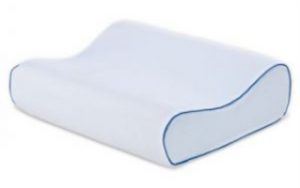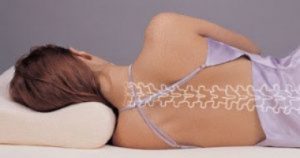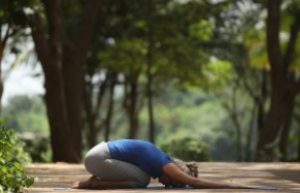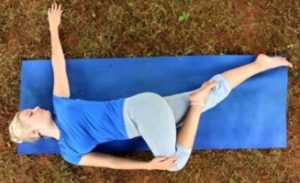How often do we wake up in the morning with stiffness and pain in the neck? You are not alone. This is one of the most common complaints of most people, but many people think it is just a sign of aging and that they have to live with it.
The recipe for a good night of sleep consists of a few simple ingredients viz: the right temperature, the minimized exposure to light, and the absence of neck pain. While the first two are easy to control, many of us struggle with the last ingredient and often wake up with a nagging ache or stiffness in our necks or shoulders.
When this happens, we often wonder if it is because of the pillow we are sleeping on…..
Choose the right pillow
The most common cause of neck stiffness in the morning is our pillows. Most of the pillows do not support our necks properly. Each individual’s neck is unique in terms of the length, thickness and muscle tension. As we sleep at night, our necks need to be well supported in a neutral position so as to give our muscles a break. A pillow that fails to support the neck is likely to cause the neck to fall into a wrong position over a long period, which inevitably causes excessive stress to the neck and leads to the pain. So what is the right pillow for your neck pains?
What Makes A Good Pillow?
A good pillow is characterised by its ability to help preserve the natural curvature of the neck, and in turn help to neck to be in a neutral position throughout the night. It is important that the muscles at the neck are supported so that they can relax and not be overworked as you sleep. Just like a good back support to help us maintain optimal back posture and prevent overworking of the back muscles, a good pillow can help us to maintain ideal neck posture at night
So what is the right pillow for your neck pains?
The best way to prevent morning stiffness and pain is to have your neck supported as you sleep. This starts with determining the type of sleeper you are: side sleeper, back sleeper or turner in bed.
The Back Sleeper
Back Sleeper is the person who lies on his/her back without a pillow, with their head usually falling downwards and their chin tilted upwards. This sleeping position puts a significant amount of stress on the neck as it aggravates the neck’s reversed “C-shape”. The situation could be more serious if they have a stiff or hunched upper back.
The pillow a Back Sleeper requires is one that fills the gap between the back of the head and the upper back, so that the natural curve of the neck can be maintained. Looking at the market, a Contour pillow is best able to meet this need.

contoured memory foam pillow
When using a contoured memory foam pillow, the higher end should be inserted underneath the hollow of the neck, closer to your shoulder.
What to look out for:
- Place your hands around your neck to feel for any muscle tightness/tension. If you are in the correct position, your neck muscles will be relaxed.
- Get someone to take a look at your neck posture from the side view. He/she should be able to draw a straight line from the ear lobe to the shoulder joint and the hip joint.
The Side Sleeper

The Side Sleeper
Like the back Sleeper, a contour or regular cervical pillow may best serve the purpose of maintaining a neutral neck for a Side Sleeper. Again, the higher end of the pillow needs to be underneath the hollow of the neck. It is advisable to visit http://www.d3home.com/ if you want to find one of the best furniture stores in California . It is also important to pull the pillow as close as possible to the top of your shoulder. The height of the contour is usually equal to the width measured from the base of the neck to the tip of the shoulder of the same side.
What to look out for:
- As shown in the picture above, the spine should form a straight horizontal line, parallel to the floor.
The Tummy Sleeper

The Side Sleeper
Although this sleeping position is not recommended, because it forces the neck to turn to one side and arch backwards excessively, some people do tend to prefer this sleeping style. For these people, a regular pillow that is soft and low is best suited. The pillow also needs to be pulled lower so that it supports the top part of the best. This helps to prevent excessive neck rotation and backward arching.
What if the stiffness and neck pain persists?
If the pain and stiffness still persist, it is highly likely that you have been suffering from this for a long time. It would be beneficial for you to seek a few sessions of treatment with a physiotherapist to get your muscles released and joints mobilized before you feel the relief. Also, paying a conscious effort to watch your posture throughout the day would help prevent the stiffness and pain from developing the next morning.
Simple Yoga techniques will help relieve neck and spine pain when practiced every morning
Balasana or Child pose

Balasana or Child pose
Kneel on the floor and place your shin on the floor with toes touching each other. Sit on your heels. With hands by your side, exhale and lay your torso down between your thighs/bend from the waist laying your torso between your thighs. Slowly allow your head to touch the ground. Do as much as possible and don’t strain yourself. Your hands should be resting by the sides of your torso with palms facing upward. Stay in this pose for as far as possible and slowly while inhaling lift yourself back to the same position, find more info at heroin.net. Place your hands on your thighs with palms facing the ceiling
Benefits: This pose not only provides relief from your neck pain and back pain but also calms your brain. It stretches the hips, thighs and ankles and makes you feel fresh like a child
Natarajasana or Reclining Twist

Natarajasana or Reclining Twist
Lie on the floor with your back straight. Slowly lift your right leg and bring it over your left leg. While the left leg remains straight, make sure that the right leg makes a right angle on the floor. Stretch your hands either ways and face rightwards. Take a few deep breaths, while being in this pose for thirty seconds. Repeat the same with your left leg.
Benefits: This pose makes your muscles more flexible
Marjariasana or Cat Stretch

Marjariasana or Cat Stretch
Sequentially, exhale and round your spine towards the ceiling and bring your head inwards. Gently bring your chin towards your chest. Continue these two poses (cow and cat pose) in sequence while you inhale and exhale.
Benefit: Provides a gentle massage to your spine and relieves neck pain
Your physiotherapist will also help you diagnose your condition and determine the underlying condition if changing your pillows have not helped you.
Experiencing neck pain? Click here to the download the ComfortMyPain App by Vissco (https://www.comfortmypain.com/) to find out more about physiotherapy for neck pain relief and other preventive fitness solutions
Check out the links:
https://www.comfortmypain.com/
https://www.vissco.com/physiotherapy-exercises/
https://www.vissco.com/fitnessexercise/
https://www.vissco.com/product/injuries/neck-injuries/cervical-contoured-pillow-small/
https://www.vissco.com/product/injuries/neck-injuries/cervical-contoured-pillow-large/
https://www.vissco.com/product/injuries/neck-injuries/cervical-pillow-regular/
https://www.vissco.com/product/injuries/neck-injuries/cervical-pillow-delux/
https://www.vissco.com/product/injuries/neck-injuries/cervical-pillow-round-soft/
https://www.vissco.com/product/injuries/neck-injuries/contoured-memory-foam-pillow/
Source:
